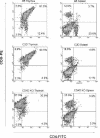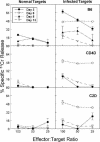Delayed clearance of Ehrlichia chaffeensis infection in CD4+ T-cell knockout mice
- PMID: 14688093
- PMCID: PMC343995
- DOI: 10.1128/IAI.72.1.159-167.2004
Delayed clearance of Ehrlichia chaffeensis infection in CD4+ T-cell knockout mice
Abstract
Human monocytic ehrlichiosis is an emerging tick-borne disease caused by the rickettsia Ehrlichia chaffeensis. To examine the role of helper T cells in host resistance to this macrophage-tropic bacterium, we assessed E. chaffeensis infections in three mouse strains with differing functional levels of helper T cells. Wild-type, C57BL/6J mice resolved infections in approximately 2 weeks. Major histocompatibility complex class II (MHCII) knockout, B6.129-Abb(tm1) mice lacking helper T cells developed persistent infections that were not resolved even after several months. CD4+ T-cell-deficient, B6.129S6-Cd4(tm1Knw) mice cleared the infection, but the clearance took 2 weeks longer than it did for wild-type mice. C57BL/6J mice resolved infection more rapidly following a second experimental challenge, but B6.129S6-Cd4(tm1Knw) mice did not. The B6.129S6-Cd4(tm1Knw) mice also developed active E. chaffeensis-specific immunoglobulin G responses that were slightly lower in concentration and slower to develop than that observed in C57BL/6J mice. E. chaffeensis-specific cytotoxic T cells were not detected following a single bacterial challenge in any mouse strain, including wild-type C57BL/6J mice. However, the cytotoxic T-cell activity developed in all three mouse strains, including the MHCII and CD4+ T-cell knockouts, when challenged with a second E. chaffeensis infection. The data reported here suggest that the cell-mediated immunity, orchestrated by CD4+ T cells is critical for conferring rapid clearance of E. chaffeensis.
Figures






Similar articles
-
Differential clearance and immune responses to tick cell-derived versus macrophage culture-derived Ehrlichia chaffeensis in mice.Infect Immun. 2007 Jan;75(1):135-45. doi: 10.1128/IAI.01127-06. Epub 2006 Oct 23. Infect Immun. 2007. PMID: 17060466 Free PMC article.
-
Persistent Ehrlichia chaffeensis infection occurs in the absence of functional major histocompatibility complex class II genes.Infect Immun. 2002 Jan;70(1):380-8. doi: 10.1128/IAI.70.1.380-388.2002. Infect Immun. 2002. PMID: 11748204 Free PMC article.
-
Evaluation of immunocompetent and immunocompromised mice (Mus musculus) for infection with Ehrlichia chaffeensis and transmission to Amblyomma americanum ticks.Vector Borne Zoonotic Dis. 2004 Winter;4(4):323-33. doi: 10.1089/vbz.2004.4.323. Vector Borne Zoonotic Dis. 2004. PMID: 15671738
-
Clinical and biological aspects of infection caused by Ehrlichia chaffeensis.Microbes Infect. 1999 Apr;1(5):367-76. doi: 10.1016/s1286-4579(99)80053-7. Microbes Infect. 1999. PMID: 10602669 Review.
-
Infections with Ehrlichia chaffeensis and Ehrlichia ewingii in persons coinfected with human immunodeficiency virus.Clin Infect Dis. 2001 Nov 1;33(9):1586-94. doi: 10.1086/323981. Epub 2001 Sep 24. Clin Infect Dis. 2001. PMID: 11568857 Review.
Cited by
-
Differential clearance and immune responses to tick cell-derived versus macrophage culture-derived Ehrlichia chaffeensis in mice.Infect Immun. 2007 Jan;75(1):135-45. doi: 10.1128/IAI.01127-06. Epub 2006 Oct 23. Infect Immun. 2007. PMID: 17060466 Free PMC article.
-
Laboratory maintenance of Ehrlichia chaffeensis and Ehrlichia canis and recovery of organisms for molecular biology and proteomics studies.Curr Protoc Microbiol. 2008 May;Chapter 3:Unit 3A.1. doi: 10.1002/9780471729259.mc03a01s9. Curr Protoc Microbiol. 2008. PMID: 18770537 Free PMC article.
-
Protective heterologous immunity against fatal ehrlichiosis and lack of protection following homologous challenge.Infect Immun. 2008 May;76(5):1920-30. doi: 10.1128/IAI.01293-07. Epub 2008 Feb 19. Infect Immun. 2008. PMID: 18285501 Free PMC article.
-
An intradermal environment promotes a protective type-1 response against lethal systemic monocytotropic ehrlichial infection.Infect Immun. 2006 Aug;74(8):4856-64. doi: 10.1128/IAI.00246-06. Infect Immun. 2006. PMID: 16861674 Free PMC article.
-
Review: Protective Immunity and Immunopathology of Ehrlichiosis.Zoonoses. 2022 Jan 6;2(1):10.15212/zoonoses-2022-0009. doi: 10.15212/zoonoses-2022-0009. Epub 2022 Jul 5. Zoonoses. 2022. PMID: 35876763 Free PMC article.
References
-
- Andrew, H. R., and R. A. Norval. 1989. The carrier status of sheep, cattle and African buffalo recovered from heartwater. Vet. Parasitol. 34:261-266. - PubMed
-
- Barry, M., and R. C. Bleackley. 2002. Cytotoxic T lymphocytes: all roads lead to death. Nat. Rev. Immunol. 2:401-409. - PubMed
-
- Beharka, A. A., J. W. Armstrong, and S. K. Chapes. 1998. Macrophage cell lines derived from major histocompatibility complex II-negative mice. In Vitro Cell Dev. Biol. Anim. 34:499-507. - PubMed
-
- Brown, W. C., T. C. McGuire, W. Mwangi, K. A. Kegerreis, H. Macmillan, H. A. Lewin, and G. H. Palmer. 2002. Major histocompatibility complex class II DR-restricted memory CD4+ T lymphocytes recognize conserved immunodominant epitopes of Anaplasma marginale major surface protein 1a. Infect. Immun. 70:5521-5532. - PMC - PubMed
Publication types
MeSH terms
Substances
Grants and funding
LinkOut - more resources
Full Text Sources
Molecular Biology Databases
Research Materials

